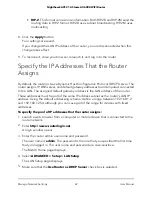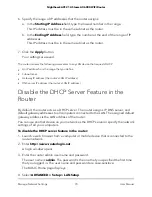
5. Configure the following settings to set up a 2.4 GHz or 5 GHz guest WiFi network:
•
Enable Guest Network
. By default, the guest WiFi network is disabled. To enable
the guest WiFi network for the
2.4 GHz or 5 GHz WiFi band, select the
Enable Guest Network
check box.
•
Enable SSID Broadcast
. By default, the router broadcasts the SSID of the WiFi
band so that WiFi stations can detect the WiFi name (SSID) in their scanned
network lists. To turn off the SSID broadcast for the 2.4 GHz or 5 GHz guest WiFi
network, clear the
Enable SSID Broadcast
check box.
•
Allow guests to see each other and access my local network
. By default, WiFi
clients that are connected to the 2.4 GHz or 5 GHz guest WiFi network cannot
access WiFi devices or Ethernet devices that are connected to the main WiFi
network. To allow access to the main WiFi network, select the
Allow guests to
see each other and access my local network
check box.
•
Guest Wireless Network Name (SSID)
. The SSID is the 2.4 GHz or 5 GHz guest
WiFi network name. The default 2.4 GHz SSID is NETGEAR_Guest. The default 5
GHz SSID NETGEAR-5G_Guest.
To change the SSID, enter a 32-character (maximum), case-sensitive name in this
field.
6. Select a WiFi security option for the 2.4 GHz or 5 GHz guest WiFi network:
•
None
. An open WiFi network that does not provide any security. Any WiFi device
can join the WiFi network. We recommend that you do not use an open WiFi
network.
•
WPA2-Personal [AES]
. This option is the default setting. This type of security
enables WiFi devices that support WPA2 to join the router’s WiFi network. If you
did not change the WiFi password, the default password displays. The default
password is printed on the router label.WPA2 provides a secure connection but
some older WiFi devices do not detect WPA2 and support only WPA. If your
network includes such older devices, select WPA-PSK [TKIP] + WPA2-PSK [AES]
security.
•
WPA-Personal [TKIP] + WPA2-Personal [AES]
. This type of security enables
WiFi devices that support either WPA or WPA2 to join the router’s WiFi network.
However, WPA-PSK [TKIP] is less secure than WPA2-PSK [AES] and limits the
speed of WiFi devices to 54 Mbps.
•
WPA/WPA2 Enterprise
. This type of security requires that your WiFi network
can access a RADIUS server.
•
WPA3-Personal
. This type of security enables WiFi devices that support WPA3
to join the router's WiFi network. WPA3 is the latest security standard and is more
secure than WPA2.
User Manual
80
Manage Network Settings
Nighthawk AX12 12-Steam AX6000 WiFi Router






























